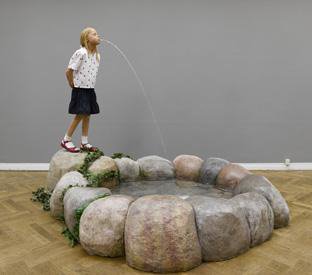iRonic
dal 30/6/2011 al 3/9/2011
Segnalato da
John Bock
Shannon Bool
Thorsten Brinkmann
Mark Dion
Anton Henning
Brigitte Kowanz
Ragnar Kjartansson
Peter Land
Patrick Mimran
Ahmet Ogut
Sener Ozmen
Claude Wall
Claudia Emmert
30/6/2011
iRonic
Kunstpalais & Stadtische Sammlung, Erlangen
Twelve artists from eight nations, who were all born between 1951 and 1981, present different forms of irony. Questions regarding art itself also play a central role, such as artists' expectations towards themselves or the viewers' expectations towards artists or art, the definition of artists' roles in society, and also contents and formal means. With an enigmatic smirk irony adds a liberal aspect of legitimate arbitrariness to our causally determined way of thinking.

John Bock (D), Shannon Bool (CDN),
Thorsten Brinkmann (D), Mark Dion (USA),
Anton Henning (D), Brigitte Kowanz (A),
Ragnar Kjartansson (IS), Peter Land (DK),
Patrick Mimran (F), Ahmet Öğüt (TR),
Şener Özmen (TR), Claude Wall (D)
Curator of the Exhibition Dr. Claudia Emmert
Director of the Kunstpalais & Städtische Sammlung Erlangen
The Exhibition
Hitting the Nerve of Our Times with Playfully Painful Precision
Twelve artists from eight nations, who were all born between 1951 and 1981, present different forms of irony in the exhibition iRonic. Die feinsinnige Ironie der Kunst (iRonic. The Subtle Irony of Art). They tackle socially relevant issues and concern themselves with political
slogans, gender roles, scientific research methods, and also with our approach towards nature. Questions regarding art itself also play a central role, such as artists’ expectations towards themselves or the viewers’ expectations towards artists or art, the definition of artists’
roles in society, and also contents and formal means. The artists’ answers to these questions
are always shrewd and subtle. They also hit the nerve of our times with playfully painful precision.
The Subject
Irony Is a New Form of Participation
Apart from being a significant current topic, irony also constitutes an essential part of our
verbal and visual communication. It is with us in everyday, socio-political or existential contexts. While signalling passionate intellectuality and playful aplomb, irony also surfaces when
we come up against certain borders, regardless of whether they are self-imposed or determined by others. At one and the same time, irony undermines and also creates distance. It
simultaneously comprises exaggeration and understatement, and the dissolution and suffusion of meaning.
Irony indicates a linguistic or visual communication strategy in which one thing is said while
something else is meant. With an enigmatic smirk it adds a liberal aspect of legitimate arbitrariness to our causally determined way of thinking.
But how does this kind of ambiguity function in a time which is defined by a multi-medial flood
of global image and text information on the one hand, and by increasingly short avenues of
communication on the other? Explicit symbols of irony designed to preclude possible misunderstandings from the start have become established in emails, tweets or text messages. But
what about irony in a multi-cultural, globalised context? Is irony actually at all possible here?
Or has irony -- quite to the contrary – long since become a lingua franca? Our global media
culture is tuned to linking circles of friends. Is it not so that this society communicates and
circulates a collective value system that also establishes common ground between people of
different origins thus creating a basis for ironic complicity between sender and recipient, and
artist and viewer?
The Background
Art Becomes Ironic
In late 2010 the curators of the Museum Morsbroich daringly used the exhibition “Neues
Rheinland (The new Rhineland)” in order to proclaim the birth of the “post-ironic generation”
at the beginning of the 21st century. A bold statement. But is it tenable? Would it not be more
to the point to say that irony is currently experiencing an impressive renaissance? Exhibitions
such as “The Fate of Irony” in the Kai 10 Raum für Kunst in Düsseldorf, which also took
place in 2010, or “Seriously Ironic”, which was already on display in 2009 in the Centre
PasquArt in Biel, are proof of the topicality of the discourse on ironically fractured communication.
Image: Peter Land
Press Conference on Friday 1 July 2011, 11 a.m.
Kunstpalais Stadt Erlangen
Palais Stutterheim
Marktplatz 1 91054 Erlangen
Opening Times:
Tue-Sun 10 a.m. – 6 p.m.
Wedn 10 a.m. – 8 p.m.
Admission: 4 Euro, reduced 2 Euro



